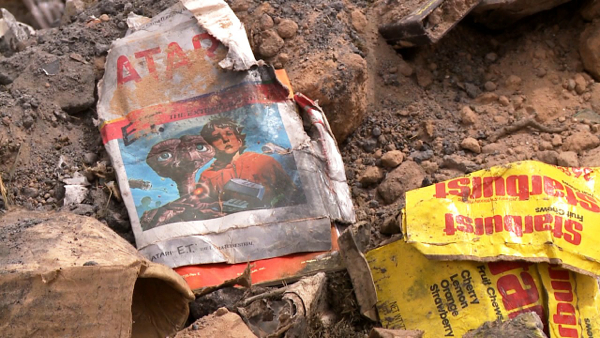Movie review by Greg Carlson
When Microsoft’s subsidiary Xbox Entertainment Studios ceased operations, only one episode of the planned series “Signal to Noise” had been produced. The first cycle of the show was originally slated to include six documentaries on various aspects of videogame culture and the videogame industry. Screenwriter and director Zak Penn, known equally for his work on the stories and scripts of popular Marvel comic book adaptations and his 2004 Werner Herzog team-up “Incident at Loch Ness,” helmed the one-off “Atari: Game Over,” which centers on the quest to dig up a purported trove of Atari merchandise interred, as hardcore fans would have it, when the company went bust back in the 80s. The movie is now available on Netflix – the platform upon which the Xbox Entertainment Studios brand was partially modeled for direct competition.
“Atari: Game Over” includes a flashy and fleet overview of the rise and fall of the titular tech company, the innovative coin-op kingpins and providers of the massively successful Atari 2600 home gaming console. The main course, however, is a drawn-out, contemporary update on the fate of the company’s maligned overstock of “E.T. the Extra-Terrestrial” cartridges, famously buried in a public landfill in Alamogordo, New Mexico on September 26, 1983. For years, the narrative of the Atari garbage dump has been told and retold as a cautionary tale about the catastrophic failure of the “E.T.” game itself and not in the context of bigger picture market saturation and financial mismanagement that more accurately account for the end of Atari.
At the very heart of the tempest in a teapot is “E.T.” game designer Howard Scott Warshaw, the crazy smart computer engineer who understood the limitations of Atari’s home platform so perfectly that his million-seller blockbuster “Yar’s Revenge” is considered by many to be among the most elegant, immersive, and entertaining games built for the 2600. Gamers will know more details than Penn has time to cover in the short timeframe, but the impossibly brief design window for “E.T.” was a mere five weeks when a typical schedule would allow for several months. “Atari: Game Over” indulges in a bit of revisionist defense on Warshaw’s behalf, arguing that “E.T.” is not all that bad, but one of the funniest scenes in the film shows frustrated players griping about the monotony of the E.T. avatar constantly, maddeningly falling down the playfield’s ubiquitous holes.
While Penn finds an affable and enthusiastic excavator in Joe Lewandowski, whose longtime experience with the landfill leads to a humorous bit comparing Lewandowski’s triangulation techniques to Indiana Jones and the Staff of Ra, the movie leaves out several of the historical anecdotes that gave rise to the “E.T.” legend in the first place, including reports that local kids raided the site to recover copies of not only “E.T.,” which ultimately represented only a fraction of the discarded Atari inventory, but also many other titles.
In addition to Warshaw and Lewandowski, Penn talks to key people like Atari co-founder Nolan Bushnell and the knowledgeable Manny Gerard, an executive with much to say about the inner workings of the videogame company’s relationship with Hollywood. No new interviews with Steven Spielberg were granted, but the “E.T.” auteur shows up in archival footage, at one point enthusing about the upcoming release of the doomed game adaptation. Additional color commentary and nerd cred is provided by “Ready Player One” author Ernest Cline, seen driving a replica E.T. to the dig in his DeLorean DMC-12 (bonus geek points that we get to see Cline pick up the vehicle from George R. R. Martin), and videogame historian and designer Mike Mika, whose personal archive bursts with more than enough content for several more documentaries.
